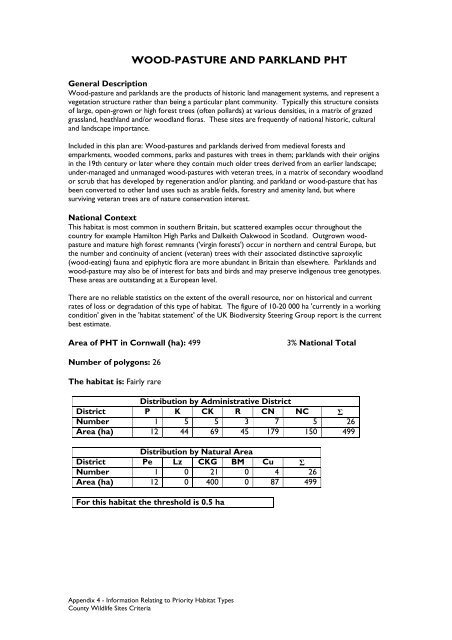County Wildife Site Criteria for Cornwall Appendices
County Wildife Site Criteria for Cornwall Appendices
County Wildife Site Criteria for Cornwall Appendices
You also want an ePaper? Increase the reach of your titles
YUMPU automatically turns print PDFs into web optimized ePapers that Google loves.
WOOD-PASTURE AND PARKLAND PHTGeneral DescriptionWood-pasture and parklands are the products of historic land management systems, and represent avegetation structure rather than being a particular plant community. Typically this structure consistsof large, open-grown or high <strong>for</strong>est trees (often pollards) at various densities, in a matrix of grazedgrassland, heathland and/or woodland floras. These sites are frequently of national historic, culturaland landscape importance.Included in this plan are: Wood-pastures and parklands derived from medieval <strong>for</strong>ests andemparkments, wooded commons, parks and pastures with trees in them; parklands with their originsin the 19th century or later where they contain much older trees derived from an earlier landscape;under-managed and unmanaged wood-pastures with veteran trees, in a matrix of secondary woodlandor scrub that has developed by regeneration and/or planting. and parkland or wood-pasture that hasbeen converted to other land uses such as arable fields, <strong>for</strong>estry and amenity land, but wheresurviving veteran trees are of nature conservation interest.National ContextThis habitat is most common in southern Britain, but scattered examples occur throughout thecountry <strong>for</strong> example Hamilton High Parks and Dalkeith Oakwood in Scotland. Outgrown woodpastureand mature high <strong>for</strong>est remnants ('virgin <strong>for</strong>ests') occur in northern and central Europe, butthe number and continuity of ancient (veteran) trees with their associated distinctive saproxylic(wood-eating) fauna and epiphytic flora are more abundant in Britain than elsewhere. Parklands andwood-pasture may also be of interest <strong>for</strong> bats and birds and may preserve indigenous tree genotypes.These areas are outstanding at a European level.There are no reliable statistics on the extent of the overall resource, nor on historical and currentrates of loss or degradation of this type of habitat. The figure of 10-20 000 ha 'currently in a workingcondition' given in the 'habitat statement' of the UK Biodiversity Steering Group report is the currentbest estimate.Area of PHT in <strong>Cornwall</strong> (ha): 4993% National TotalNumber of polygons: 26The habitat is: Fairly rareDistribution by Administrative DistrictDistrict P K CK R CN NC ΣNumber 1 5 5 3 7 5 26Area (ha) 12 44 69 45 179 150 499Distribution by Natural AreaDistrict Pe Lz CKG BM Cu ΣNumber 1 0 21 0 4 26Area (ha) 12 0 400 0 87 499For this habitat the threshold is 0.5 haAppendix 4 - In<strong>for</strong>mation Relating to Priority Habitat Types<strong>County</strong> Wildlife <strong>Site</strong>s <strong>Criteria</strong>
















